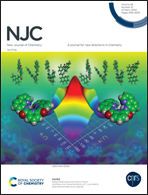Physicochemical properties of functionalized A200 and SBA-15 nanoparticles with enhanced amphiphilicity for Pickering emulsions†
Abstract
Pickering emulsions are considered as promising chemical oil repellents in enhanced oil recovery (EOR). In this paper, an amphiphilic block copolymer poly(ethylene glycol)–poly(dopamine methacrylamide) (mPEG–PDMA, abbreviated as mp) containing catechol adhesion groups was synthesized. The surface modification of A200 and SBA-15 nanoparticles was carried out using the strategy of dip-coating with mp solution, and the emulsification properties of the two modified particles and their stability were comparatively investigated. The results showed that both modified particles could achieve excellent emulsification performance. The best emulsification effect was achieved when the concentration of A200-mp and SBA-15-mp particles was 2.5 mg mL−1 and the oil phase volume fraction was 0.5. The emulsions stabilized by SBA-15-mp tended to be invertible when the volume fraction of the oil phase was 0.7 or pH = 2–3 or when NaCl was added, and O/W emulsions could be inverted into W/O types. Interestingly, the emulsions stabilized by A200-mp particles showed good acid resistance, alkali resistance, high salt resistance, multiple oil phase applicability and centrifugal shear stability. In the simulated rock permeation experiments, the emulsions prepared using A200-mp particles could stably permeate in the silica sand column without an obvious chromatographic separation effect, which is promising for application in tertiary oil recovery.



 Please wait while we load your content...
Please wait while we load your content...